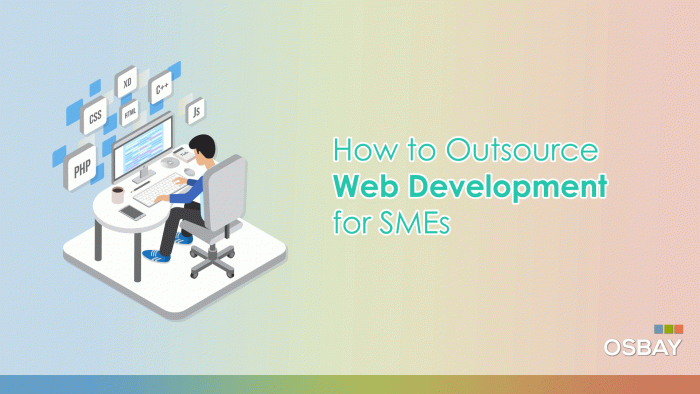In the digital age, a robust online presence is crucial for small and medium-sized enterprises (SMEs). However, building and maintaining a high-quality website can be resource-intensive. Outsourcing web development offers a strategic solution, allowing SMEs to leverage external expertise while focusing on core business activities. This guide explores the benefits, challenges, and best practices for outsourcing web development effectively.
Understanding the Importance of Web Development for SMEs
A well-designed website serves as the digital storefront for your business, influencing customer perceptions and driving conversions. For SMEs, a professional website can:
- Enhance Credibility: A polished online presence builds trust with potential customers.
- Expand Reach: Online platforms enable businesses to reach a broader audience beyond local markets.
- Improve Customer Engagement: Interactive features and user-friendly design enhance user experience.
- Drive Sales: E-commerce capabilities facilitate online transactions, boosting revenue.
Investing in quality web development is not just about aesthetics; it’s a strategic move to stay competitive in today’s market.
Why Outsource Web Development?
Outsourcing web development offers several advantages for SMEs:
- Cost Efficiency: Hiring an in-house team involves salaries, benefits, and infrastructure costs. Outsourcing reduces these expenses by paying only for the services needed.
- Access to Expertise: External agencies bring specialized skills and experience, ensuring high-quality outcomes.
- Faster Time-to-Market: Experienced developers can expedite the development process, allowing quicker deployment.
- Focus on Core Business: Delegating technical tasks enables SMEs to concentrate on strategic initiatives and operations.
By outsourcing, SMEs can achieve professional results without the overhead of managing an internal development team.

Choosing the Right Outsourcing Model
Selecting an appropriate outsourcing model is critical. Common models include:
- Project-Based Outsourcing: Suitable for well-defined projects with clear objectives. The vendor handles the entire project from start to finish.
- Dedicated Team Model: Ideal for ongoing development needs. A team of developers works exclusively on your projects, providing continuity.
- Staff Augmentation: Involves hiring individual developers to supplement your in-house team, offering flexibility and control.
Each model has its pros and cons. Assess your project’s scope, duration, and complexity to determine the best fit.
Steps to Successfully Outsource Web Development
1. Define Your Project Requirements
Clearly outline your project’s goals, features, and functionalities. Consider aspects such as:
- Target audience and user personas
- Design preferences and branding guidelines
- Technical specifications and platform requirements
- Budget constraints and timelines
A detailed project brief ensures alignment between your expectations and the vendor’s deliverables.
2. Research and Shortlist Potential Vendors
Identify potential outsourcing partners by:
- Reviewing portfolios and case studies
- Checking client testimonials and reviews
- Assessing technical expertise and industry experience
- Evaluating communication skills and responsiveness
Platforms like Clutch, Upwork, and GoodFirms can provide valuable insights into vendors’ reputations.
3. Evaluate Proposals and Conduct Interviews
Request detailed proposals outlining:
- Project approach and methodology
- Estimated timelines and milestones
- Cost breakdown and payment terms
- Team composition and roles
Conduct interviews to assess cultural fit, communication styles, and problem-solving abilities.
4. Establish Clear Contracts and Agreements
Draft comprehensive contracts covering:
- Scope of work and deliverables
- Confidentiality and non-disclosure agreements
- Intellectual property rights
- Payment schedules and terms
- Dispute resolution mechanisms
Legal clarity protects both parties and sets expectations for the engagement.
5. Implement Effective Communication and Project Management
Maintain regular communication through:
- Scheduled meetings and progress updates
- Collaborative tools like Slack, Trello, or Asana
- Clear documentation and feedback channels
Effective project management ensures transparency, accountability, and timely delivery.
Common Challenges and How to Overcome Them
Communication Barriers
Differences in language, time zones, and cultural norms can hinder communication. Mitigate these by:
- Establishing clear communication protocols
- Utilizing collaboration tools for real-time updates
- Scheduling meetings accommodating both parties’ time zones
Quality Assurance
Ensuring the final product meets quality standards is vital. Achieve this by:
- Defining clear quality benchmarks and testing procedures
- Conducting regular code reviews and user testing
- Engaging third-party QA specialists if necessary
Scope Creep
Uncontrolled changes can derail projects. Prevent scope creep by:
- Clearly defining project scope and objectives
- Implementing change management processes
- Regularly reviewing progress against the initial plan
Cost Considerations
Outsourcing costs vary based on factors like location, expertise, and project complexity. Average hourly rates are:
- Eastern Europe: $30 – $70
- Asia (e.g., India, China): $20 – $60
- Latin America: $40 – $100
- North America: $100 – $200
Consider the trade-offs between cost and quality when selecting a vendor.
Post-Development Support and Maintenance
After deployment, ongoing support is essential for:
- Bug Fixes: Addressing any issues that arise post-launch.
- Updates: Implementing new features or updates as needed.
- Security: Ensuring the website remains secure against threats.
- Performance Monitoring: Tracking site performance and user engagement.
Discuss post-launch support options with your vendor to ensure long-term success.
Conclusion
Outsourcing web development can be a strategic move for SMEs, offering access to expertise, cost savings, and flexibility. By carefully selecting the right outsourcing model, defining clear project requirements, and maintaining effective communication, SMEs can achieve successful outcomes and focus on their core business objectives.

